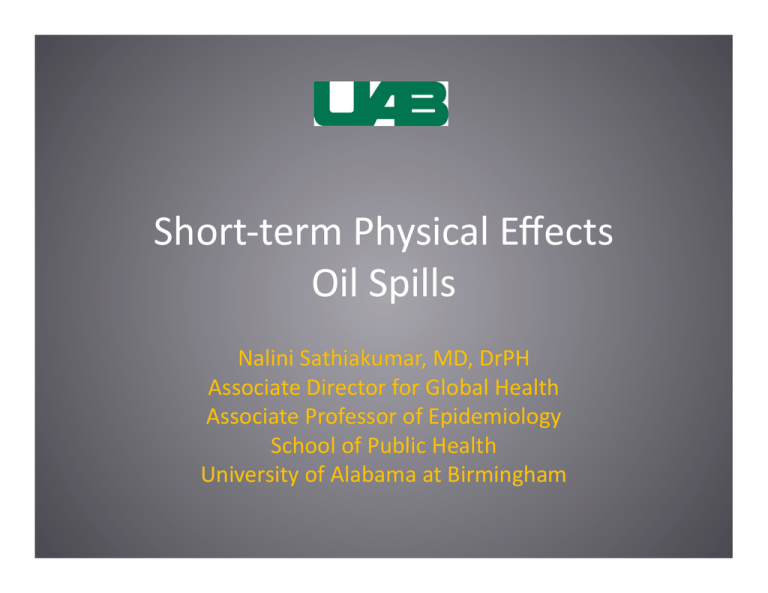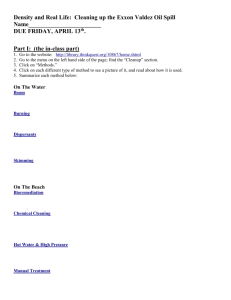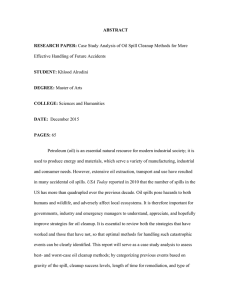Short-‐term Physical Effects Oil Spills
advertisement

Short-­‐term Physical Effects Oil Spills Nalini Sathiakumar, MD, DrPH Associate Director for Global Health Associate Professor of Epidemiology School of Public Health University of Alabama at Birmingham Background • • • • • • Crude oil Exposures Acute toxic effects Physical injuries Target populaJon Summary Crude oil • Crude oil (liquid petroleum) occurs naturally and consists of a complex mixture of hydrogen and carbon • When a spill occurs: – Oil slick on the surface – Gases volaJle organic compounds (VOCs) evaporate (small amount dissolves in water) – Oil residue + water → thick mousse – Part of oil sinks + suspended parJculate maTer → tar balls – Oil dispersants → break up oil on the water surface → Jny oil drops easily mix with the water and get diluted – Over Jme oil waste disintegrates Short-­‐term Physical Effects Exposures • Chemical exposures • Crude oil may include benzene and other volaJle organic compounds (VOCs – benzene, ethylbenzene, toluene, xylene, napthalene), oil mist, polycyclic aromaJc hydrocarbons (PAHs), diesel fumes and heavy metals (aluminum, cadmium, nickel, lead and zinc) • Oil dispersants may include sulfonic acid salt (detergent), propylene glycol, 2-­‐butoxyethanol (solvent) and petroleum disJllates (mixture of paraffins that may contain a small amount of aromaJc hydrocarbons) • Physical hazards may include ergonomic hazards, excessive noise levels, sun exposure and heat stress; injuries may occur due to slips, trips Acute Toxic Effects – Crude Oil Chemical Route of exposure Symptoms* VOCs (ethylbenzene, xylene) PAH Dermal (contact) Skin/mucous membranes: erythema (redness), edema (swelling), irritaJon, dermaJJs (rash, blisters) VOCs (benzene, ethylbenezene, xylene) InhalaJon (air) Contact Ocular (eyes): redness, soreness, watering, itching VOCs (benzene, ethylbenzene) InhalaJon (air) Respiratory: cough, throat irritaJon (dry, scratchy, sore), shortness of breath, wheezing VOCs (benzene, toluene) InhalaJon (air) Neurological: nausea/vomiJng, headache, dizziness, irritability, confusion, weakness of extremiJes VOCs IngesJon (food, water) GastrointesDnal tract disturbances: transient nausea, possibly vomiJng, and self-­‐limiJng diarrhea * Symptoms more pronounced in sensiJve individuals Acute Toxic Effects – Oil Dispersants Chemical Route of exposure Symptoms* 2-­‐butoxyethanol, Petroleum DisJllate (oil mist ) Dermal (contact) Skin/mucous membranes: irritaJon of skin 2-­‐butoxyethanol Petroleum DisJllate (oil mist, aromaJc hydrocarbons ) InhalaJon (air) Contact Ocular (eyes): watering, itching 2-­‐butoxyethanol Petroleum DisJllate (oil mist, aromaJc hydrocarbons ) InhalaJon (air) Respiratory: cough and throat irritaJon * Symptoms more pronounced in sensiJve individuals Physical Injuries Risk factor Outcome Slippery or uneven working surfaces Slips, trips and falls Use of tools, equipment, machinery and tools, working with wild animal (birds, fish) Injuries Strenuous work schedules, heavy physical workload, long duraJon of work FaJgue and lumbar pain ExerJon, hot environment Heat-­‐related health condiJons Target PopulaJon • Seamen and rescue workers (cleanup, bird cleaning, coast guards etc.) working in close proximity to oil spill – Exposed to many different chemical, physical and psychological hazards • Residents living in close proximity to the oil spill – Exposed to poor air quality, acute and chronic chemical exposure, psychological hazards ; pregnant women and young children more vulnerable • People eaDng fish and seafood from the areas with oil spill – Possible exposure to toxic chemicals due to ingesJon of contaminated seafood • Tourists and people using affected beaches – Chemical exposure Results from Previous Studies of Oil Spills from Supertankers • Study CharacterisJcs • Outcome/Exposure • Results – Toxic effects – Injuries – Genotoxicity/endocrine effects • Conclusions Epidemiological Studies on Tanker Oil Spills Vessel name Date Spill size (tons) LocaDon 1 Exxon Valdez* 24 Mar 1989 37,000 USA 2 MV Braer 5 Jan 1993 85,000 UK 3 Sea Empress 15 Feb 1996 72,000 UK 4 Nakhodka 2 Jan 1997 > 6,000 Japan 5 Erika 12 Dec 1999 20,000 France 6 PresJge 19 Nov 2002 63,000 Spain 7 Tasman Spirit 26 Jul 2003 37,000 Pakistan * Examined only psychosocial end points Only 7 of 38 supertanker oil spills studied to date Study CharacterisJcs of Previous Studies on Oil Spills • Study design: Most were cross-­‐secJonal studies; involves studying a subset of a populaJon with regard to exposure and outcome at the same Jme, in which, groups can be compared (exposed vs. unexposed) • Exposure: Except for one study, none had done quanJtaJve exposure measurements; used surrogates of exposure: • Community: distance from the incident, living along the coast • Cleanup operaJons crew: type of job, duraJon • Outcome Ascertainment: Acute toxic symptoms -­‐ standard quesJonnaires General health – standard quesJonnaire Specific organ funcJoning – lung, kidney and liver funcJon tests Injuries -­‐ quesJonnaire GeneJc toxicity -­‐ comet assays, micro nucleus tests, SCE and metabolic geneJc polymorphisms • Endocrine toxicity-­‐ blood (plasma) concentraJons of prolacJn and corJsol levels • • • • • MK Braer (UK, 1993) Summary of Epidemiologic Studies Study characterisDcs Cross secDonal (Campbell et al. 1993) Immediate Community* all ages Exposed residents (N=420) within 4-­‐5 km of the spill Controls living 95 km away (N=92) Exposure/Outcome QuesJonnaires of acute symptoms Peak expiratory flow, hematology, liver and renal funcJon tests Blood and urine toxicology screening Cross secDonal (Campbell et al. 1994) Follow up aper 6 months General health quesJonnaire Community* all ages Residents (N=344) and controls (N=77) Peak expiratory flow, urine analysis, hematology, and liver and renal funcJon tests Results Toxic Symptoms Major health effects on days 1 and 2 (neurological, ocular (eyes), respiratory) Lung, liver and kidney funcDon No significant differences between exposed and controls for any of the biomarkers Exposure screening Toxicological studies did not show any exposure known to affect human health General health Mean general health quesJonnaire score of exposed significantly greater than controls Lung, liver and kidney funcDon Lung funcJon within normal range No change in biomarker levels between the two Jme periods MV Braer (UK, 1993) – cont’d… Study characterisDcs Cross secDonal (Crum, 1993) Immediate Community children Children living close to shipwreck (N=44) at 3 days and (N = 56) at 9–12 days aper oil spill Outcome Peak expiratory flow rate Results Lung funcDon Peak expiratory flow rates were within the normal range at 3 days and at 9-­‐12 days No deterioraJon seen over the study period Longitudinal (Cole et al. 1997) Genotoxicty One year follow-­‐up Primary DNA damage -­‐ DNA No evidence of genotoxicity adducts in the mononuclear Community (30–49 years) cell fracJon and frequency of Genotoxicity in residents (N= hprt mutaJons in 26) and controls (N=9) at 3 T-­‐lymphocytes sampling Jmes (10 days, 10 weeks and 1 year aper the incident) Sea Empress (UK, 1996) Summary of Epidemiologic Studies Study characterisDcs Cross-­‐secDonal (Lyons et al.1999) Immediate (7 weeks aper the incident) Community (18–65 years)* Residents (N=539) controls (N=550) Cross-­‐secDonal (Gallacher et al. 2007) Immediate (7 weeks aper the incident) Community (18–65 years)* Exposed (N = 794) controls (N = 791) * Same populaJon Outcome Results Toxic symptoms QuesJonnaires of acute symptoms Exposed had significant increase in neurological, ocular (eyes) and respiratory symptoms QuesJonnaires of acute toxic and non-­‐toxic symptoms HAD Scale Toxic symptoms Toxic symptoms reporJng was associated with oil exposure and with raised perceived risk Nakhodka (Japan, 1997) Summary of Epidemiologic Study Study characterisDc Exposure/Outcome Cross-­‐secDonal (Morita et al. 1999) Immediate QuesJonnaires Cleanup workers (40-­‐70 years) Exposed (N=282) Results Toxic symptoms Primary symptoms reported were neurological, ocular(eyes) and upper respiratory symptoms Physical injuries Low back pain PPE use PPE use: gloves (100%), masks (women, 87%; men, 35%), glasses (<30%) Personal air samplers to measure benzene, toluene and xylene Exposure Hydrocarbons levels in air significantly below occupaJonal safety levels Urine toxicity levels Unremarkable Erika (France, 1999) Summary of Epidemiologic Study Study characterisDcs Cross-­‐secDonal (Schvoerer et al, 2000) Immediate Community including cleanup workers and volunteers (N = 3,669) Outcome Results Toxic symptoms QuesJonnaires and telephone Neurological, dermal (skin), ocular (eyes) and interviews on acute symptoms respiratory symptoms Physical injuries Lumbar pain DuraJon of cleaning work idenJfied as risk factor PresJge (Spain, 2002) Summary of Epidemiological Studies Study characterisDcs Cross-­‐secDonal (Suarez et al. (2005)* Immediate Cleanup workers (16+ years) 133 seamen, 135 bird cleaners, 266 volunteers and 265 paid workers (N = 799) Cross-­‐secDonal (Carrasco et al. 2006)* Immediate Exposure/Outcome QuesJonnaire on exposure condiJons and acute health problems QuesJonnaire on exposure condiJons, acute health problems Cleanup workers (16+ years) 133 seamen, 135 bird cleaners, 266 Use of personal protecJve volunteers and 265 paid workers equipment (PPE) and health-­‐ (N = 799) protecJon informaJon received * Same populaJon Results Toxic symptoms Toxic effects higher among seamen compared to other groups Injuries Bird cleaners had highest occurrence of injuries (bruises, deep wounds, sprains, fractures etc.); working 20+ days in highly polluted areas associated with increased risk of injury Toxic symptoms Seamen, the most exposed group, had the highest frequency of symptoms PPE use Health-­‐protecJon briefing associated with use of PPE Uninformed and worst-­‐informed subjects (paid workers and seamen) had increased toxic symptoms PresJge (Spain, 2002) cont’d.. Study characterisDcs Cross-­‐SecDonal (Zock et al. 2007) 1 year aper spill Cleanup workers (17 – 80 years) (N = 6780) Exposure/Outcome Results Chronic symptoms QuesJonnaires with qualitaJve Risk of lower Respiratory tract and quanJtaJve informaJon symptoms (LRTS) increased on cleanup acJviJes and with the number of exposed respiratory symptoms days, exposed hours per day and number of acJviJes Excess risk of LRTS decreased with Jme PresJge (Spain, 2002) cont’d.. Study characterisDcs Cross-­‐secDonal (Laffon et al. 2006) Immediate Workers cleaning and conducDng autopsies on birds (20-­‐35 years) Exposed (N = 34) Controls (N = 35) Cross-­‐secDonal (Pérez-­‐Cadahía et al. 2006) Immediate Exposure/Outcome Environmental VOC using passive diffusion sampling Genotoxicity biomarkers: Comet assay, SCE, MN test DNA repair geneJc polymorphisms Environmental VOC using passive diffusion sampling Volunteers and cleanup workers (18-­‐50 years) Genotoxicity biomarkers: 25 volunteers, 20 hired manual Comet assay, SCE, MN test workers (MW) and 23 hired high-­‐ pressure workers (HPW) (N = 68) Controls (N = 42) Results VOC exposure Level of VOCs within the range observed in urban environments of low-­‐contaminated ciJes Levels of benzene did not exceed threshold limit values Genotoxicity Exposed individuals had higher DNA damage, but not cytogeneJc damage, related to Jme of exposure VOC exposure Highest VOC levels in volunteers’ environment Genotoxicity Significant increase in comet assay in exposed individuals indicaJng genotoxic damage No effect of using protecJve mask during cleanup PresJge (Spain, 2002) cont’d.. Study characterisDcs Exposure/Outcome Cross-­‐secDonal (Pérez-­‐Cadahía et al. 2007) Environmental VOC using passive Immediate diffusion sampling Assessment of heavy metals in blood (Al, Volunteers and hired workers Cd, Ni, Pb, Zn) in peripheral blood (18-­‐50 years) 25 volunteers, 20 MW and 23 HPW (N = 68) Controls (N = 42) Genotoxicity biomarkers: SCE, prolacJn and corJsol levels Metabolic geneJc polymorphisms Results VOC and heavy metals exposure Highest VOC levels in the volunteer’s environment Significant increase in the levels of Al, Ni and Pb, and decrease of Zn, in exposed individuals Genotoxocity/endocrine Significant increase in SCE rate in exposed, influenced by age, sex, smoking; significant decrease in prolacJn and corJsol levels in exposed subjects Cross-­‐secDonal (Pérez-­‐Cadahía VOC and heavy metals exposure et al. 2008a) Assessment of heavy metals in blood (Al, Significant increase in levels of Al, 3-­‐4 months aper study Cd, Ni, Pb, Zn) in peripheral blood Ni and Pb, and decrease of Zn, in exposed group Volunteers and cleanup workers (18-­‐50 years)* Genotoxocity/endocrine 61 volunteers, 59 MW and 60 Genotoxicity biomarkers: Comet assay, Significant increase in comet assay; HPW (N = 180) SCE, MN test decrease in corJsol levels in Controls (N = 60) Hormone (prolacJn and corJsol) exposed group; higher DNA damage Metabolic geneJc polymorphisms in the exposed groups PresJge (Spain, 2002) cont’d.. Study characterisDcs Exposure/ Outcome Cross-­‐secDonal (Pérez-­‐Cadahía et al. 2008b) Assessment of heavy metals in 3-­‐4 months aper study blood (Al, Cd, Ni, Pb, Zn) in peripheral blood samples Volunteers and cleanup workers (18-­‐50 years)* Genotoxicity biomarkers: 61 volunteers, 59 MW and 60 Comet assay, SCE, MN test. HPW (N = 179) Hormone (prolacJn and corJsol) Cross-­‐secDonal (Pérez-­‐Cadahía et al. 2008c) Immediate Results Genotoxicity/endocrine Pb was related to the comet assay. CorJsol plasma concentraJon influenced by Al and Ni inversely and by Cd posiJvely. Strong associaJon between Cd and prolacJn levels Genotoxicity Genotoxic assessment of DNA: Increases in MN frequency and MN test decreases in the proliferaJon index Metabolic geneJc polymorphisms observed in individuals Volunteers and cleanup workers DNA repair geneJc polymorphisms with longer Jme of exposure (18-­‐50 years)* 59 volunteers, 53 MW and 47 HPW (N = 159) Controls (N = 60) *Same populaJon Tasman Spirit (Pakistan, 2003) Summary of Epidemiological Studies Study characterisDcs Cross-­‐secDonal (Janjua et al. 2006) Immediate Exposure/Outcome QuesJonnaires Residents (15+ years) Exposed residents (N = 216) and controls living 1mile (N = 83) and 8 miles(N = 101) far from the coastline Cross secDonal (Khursid et. 2008) Immediate Vendors/residents Health symptoms of vendors working/living in the vicinity (N= 100) Results Toxic symptoms Moderate-­‐to-­‐strong associaJons between the exposed group and symptoms A trend of decreasing symptom-­‐specific risk of symptoms with increase in distance from the spill site Hematological, liver and renal Hematological and biochemical funcDon parameters Lymphocyte and eosinophil levels slightly elevated Liver and renal funcJon tests 11 persons had raised SGPT, not significant Hydrocarbon/organic content in seawater and sand samples Exposure Seawater had no traces of hydrocarbon content Tasman Spirit (Pakistan, 2003) cont’d.. Study characterisDcs Cross secDonal (Meo et al. 2009) Immediate Outcome Toxic symptom quesJonnaire General health symptoms Cleanup workers Male nonsmoking workers (N=50) and controls (N=50) Cross secDonal (Meo et al. 2008) Immediate Cleanup workers (27-­‐ 30 years) Exposed (N=20) and controls (N=31) Lung funcJon: spirometry Results Toxic symptoms Cleanup workers had a higher prevalence of ocular (eyes), respiratory and general symptoms compared to controls Lung funcDon Significant reducJon in lung funcJons (FVC, FEV1, FEF25–75% and MVV) among cleanup workers Lung funcJon parameters improved when subjects were withdrawn from the polluted environment Conclusions: Exposure • Hydrocarbons below occupaJonal safety levels • Level of VOCs within the range observed in urban environments; highest VOCs in volunteers’ environment • Level of benzene did not exceed threshold limit values Conclusions: Toxic symptoms -­‐ Community (residents living in the vicinity of the oil spill) • Consistent evidence of acute toxic effects (neurological, ocular, respiratory) among the community aper adjustment of pre-­‐exisJng allergic and medical condiJons – Symptoms associated with exposure (living in the vicinity or volunteers) • Biochemical tests for lung, kidney and liver funcJon within normal limits; six months aper oil spill similar finding – Children’s respiratory funcJon within the normal range Conclusions: Toxic Symptoms – Cleanup Workers • Consistent reporJng of acute toxic symptoms (dermal, ocular, respiratory, neurological) • DuraJon of cleaning work was a risk factor • Seamen had the highest occurrence of toxic symptoms compared to volunteers or paid workers • Lower respiratory tract symptoms noted aper one year associated with number of days worked and tasks/day • ReducJon in lung funcJon was transient; improved when withdrawn from polluted environment PPE use • Less than opJmal; health briefing increased use of PPE and reducJon of symptoms • Uninformed and poorly-­‐informed workers were at more risk of exposure and symptoms Conclusions: Injuries -­‐ Cleanup Workers • Employment for more than 20 days was associated with increased risk of injures • Bird cleaners had a higher frequency of injuries compared to other cleanup workers • Cleanup and volunteer workers reported back pain Conclusions: GeneJc and Endocrine Toxicity • MV Braer tanker spill: no genotoxicity noted • PresJge tanker spill: – Volunteers doing bird cleaning/autopsies exhibited DNA damage, but not cytogeneJc damage – Manual work volunteers had the highest level of VOCs compared to hired manual or hired high-­‐pressure water machine workers; exposure associated with genotoxic damage strongly influenced by gender, age and smoking status but not by PPE use; alteraJons in hormonal status (prolacJn and corJsol concentraJons) – Increased levels of heavy metal exposure (aluminum, nickel and lead) associated with DNA damage and plasma prolacJn concentraJon; several geneJc polymorphisms in metabolizing enzymes and DNA repair proteins; use of PPEs had no effect • Long-­‐term studies are needed to clarify potenJal genotoxic and endocrine changes LimitaJons • Most studies were at a point in Jme (cross-­‐ secJonal); cannot establish a temporal relaJonship between exposure and outcome • A few studies had no comparison groups limiJng interpretaJons • Some studies were small in size • PotenJal for informaJon/publicity bias in reporJng illness occurrence • Low parJcipaJon (eg. MV Braer) LimitaJons -­‐ cont’d.. • Dependence on surrogate esJmates of exposure (distance from oil spill or living in the vicinity) • Inability to develop useful dose-­‐response data • Biomonitoring (exposure/outcome) – limited and at one point in Jme • No long-­‐term follow-­‐up of high-­‐risk groups for exposure and/or outcome assessment Thank You

